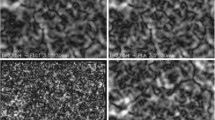Abstract
We study the evolution of artificial granulation on the basis of 2-D hydrodynamical simulations. These clearly show that granules die in two different ways. One route to death is the well known bifurcation or fragmentation of a large granule into 2 smaller ones (exploding granules). The other pathway to death is characterized by merging intergranular lanes and the accompanying dissolution of the granule located between them. It is found that the lifetime and maximum brightness is independent of the way in which granules evolve and die. They clearly differ in size, however, with exploding granules being in general significantly larger.
Similar content being viewed by others
References
Freytag, B., Ludwig, H.-G. and Steffen, M.: 1996, ‘Hydrodynamical models of stellar convection. The role of overshoot in DA white dwarfs, A-type stars, and the Sun', Astron. Astrophys. 313, 497.
Gadun, A.S. and Vorobyov, Yu. Yu.: 1995, ‘Artificial Granules in 2-D Solar Models', Sol. Phys. 159, 45.
Gadun, A.S. and Pikalov, K.N.: 1996, ‘Two-Dimensional Hydrodynamical Modeling of Solar Granules: The Power Spectrum of Simulated Granules', Astron. Rep. 40, 578.
Gadun, A.S., Solanki, S.K., Ploner, S.R.O., Hanslmeier, A., Pikalov, K.N., and Puschman, K.: 1998, ‘Scale Dependent Properties of Artificial Solar Granulation Derived from 2-D Simulations', Astron. Astrophys., in preparation.
Hirzberger, J., Vázquez, M., Bonet, J.A., Hanslmeier, A. and Sobotka, M.: 1997, ‘Time Series of Solar Granulation Images. I. Differences between Small and Large Granules in Quiet Regions', Astrophys. J. 480, 406.
Muller, R.: 1989, ‘Solar Granulation: Overview', in Solar and Stellar Granulation, eds. Rutten, R.J. and Severino, G., Kluwer Academic Press, C 263, 101.
Nordlund, Å.: 1985, ‘Solar Convection', Sol. Phys. 100, 209.
Rast, M.P.: 1993, ‘On the nature of “exploding” granules and granule fragmentation', Astrophys. J. 443, 863.
Spruit, H.C., Nordlund, Å. and Title, A.M.: 1990, ‘Solar Convection', Annu. Rev. Astron. Astrophys. 28, 263.
Stein, R.F., Nordlund, Å, and Kuhn, J.R.: 1989, ‘Convection and Waves', in Solar and Stellar Granulation, eds. Rutten, R.J. & Severino, G., Kluwer Academic Press, C 263, 381.
Title, A.M., Tarbell, T.D., Simon, G.W. and the SOUP Team: 1986, ‘White-light movies of the solar photosphere from the soup instrument on space lab 2', Adv. Space Res. 6, 253.
Author information
Authors and Affiliations
Rights and permissions
About this article
Cite this article
Ploner, S., Solanki, S.K., Gadun, A.S. et al. Temporal Evolution of Artificial Solar Granules. Space Science Reviews 85, 261–268 (1998). https://doi.org/10.1023/A:1005102617428
Issue Date:
DOI: https://doi.org/10.1023/A:1005102617428




